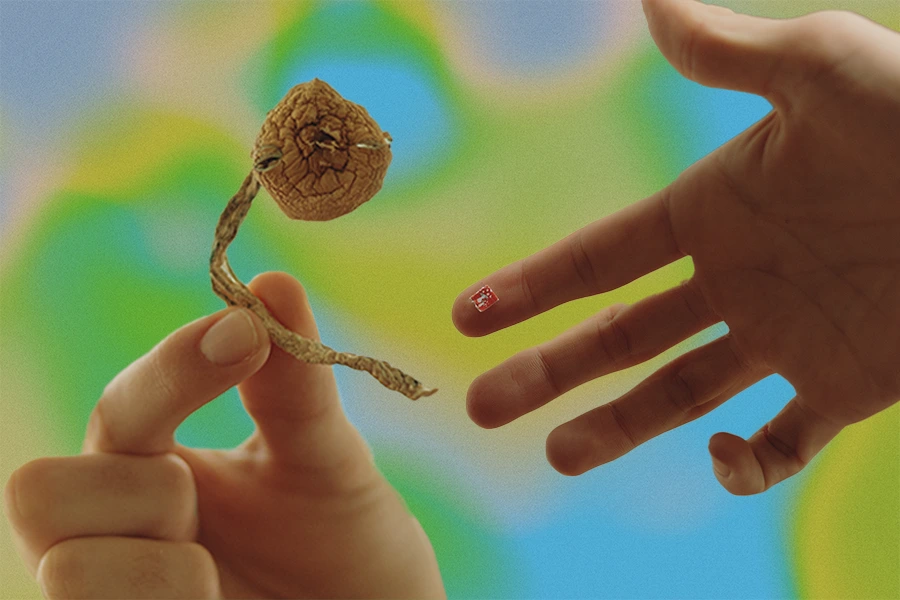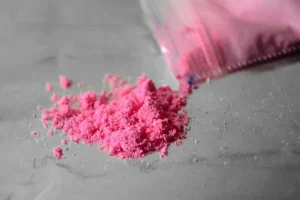LSD and psilocybin could offer promising therapeutic potential for the treatment of chronic pain “on a mechanistic and experiential level,” according to a newly published literature review that highlights scientific findings happening as part of the “psychedelic renaissance”—a recent thawing of stigma and opposition into psychedelics research after decades of prohibition.
What’s more, authors note, the pain-relieving effects of LSD and psilocybin seem to increase with repeated treatment, unlike opioids, which display “decreased therapeutic effect” over time.
The narrative review, published last month in the South African Medical Journal, charts both the history of the two substances as well as scientists’ emerging understanding of their methods of action. It notes that the drugs seem not just to reduce pain but also better manage the experience of pain.
READ: Microdosing for Chronic Pain: Does it Actually Help?
“Recent neuroimaging studies combined with small sample interventions with classic psychedelic agents,” authors wrote, “may point towards a possible means of improving the treatment of chronic pain on a mechanistic and experiential level.”
Classic psychedelics, the literature review explains, are those that bind to the central nervous system’s 5-HT2A receptors. They include both LSD and psilocybin.
The way psilocybin binds to receptors in the central nervous system “has similar effects to LSD on cognition, emotional processing, self-awareness and the perception of pain,” says the literature review, “which underpins its potential therapeutic benefit in treating people suffering with pain. Numerous small trials of LSD and psilocybin for chronic pain have already shown a good safety profile, with minimal physical dependence, withdrawal syndrome, or compulsive drug seeking compared with other analgesic agents.”
While the two drugs are part of the same family of alkaloids, their history is, of course, much different. The review describes explains that LSD was first synthesized in 1938, meaning humans have used it for less than a century. Psilocybin’s use stretches back thousands of years. In the modern U.S., psilocybin use was popularized in the late 1950s, while LSD grew to prominence in the ’60s and ’70s.
How to Grow Shrooms Bundle
Take Both of Our Courses and Save $90!
While there have been no reports of direct mortality from either substance and no withdrawal following chronic use, the study says, “the use of psilocybin in clinical research ended at the same time as LSD research as the Controlled Substances Act was enforced.”
Associations with counterculture and anti-government sentiment meant LSD and psilocybin research was abandoned, authors wrote. “From 1977 until the early 2000s, no more LSD research was published, despite overwhelming evidence pointing towards therapeutic benefit.”
Prior research had indicated LSD might be useful in treating depression, pain, and physical suffering in cancer patients and others. Among seven patients with phantom limb pain, participants treated with LSD reduced their analgesic requirements, and two patients’ pain was resolved.
During what the review refers to as the modern “psychedelic renaissance” or “the new wave of psychedelic research,” studies have found that psilocybin or LSD may help reduce cluster headaches, end-of-life depression in cancer patients and chronic pain.
READ: LSD: Everything You Should Know
In a pain study, a small sample of patients who self-medicate with the psychedelics “revealed a decrease in the experience of pain during the psychedelic session and for up to 5 days after treatment, before their pain returned to baseline.”
“The most exciting revelation from these interviews relates to the lasting psychological and emotional effect the psychedelics had on those interviewed,” the review says. “They describe increased resilience, body-self-awareness and psychological flexibility and psychological flexibility, which led to feelings of acceptance, agency and hope.”
“Most recently, the journal Pain published a case series of three people with chronic neuropathic pain who took low-dose psilocybin, termed ‘microdosing’, to manage their symptoms,” it continues. “The authors commented on the favourable effects of microdosing, with minimal side-effects and a decreased need for traditional analgesic agents.”
The article repeatedly notes that part of what’s appealing about LSD and psilocybin in the treatment of pain is that the experience of pain is multidimensional—something psychedelics seem to effectively address.
“People with pain have extensive psychological, social and spiritual needs, and may desire to reclaim an internal locus of control to address unresolved family and relationship issues,” it says at one point. “Recent developments in the approach to managing chronic pain have expanded treatment modalities beyond oral analgesics and interventional pain procedures. Today we include psychological support, patient education and physical therapy to manage people with pain.”
The review also touches on some of the mechanisms of action that might underlie the therapeutic effects on pain.
“The analgesic action of LSD and psilocybin via [the descending noxious inhibitory control system], as well as cortical processing, provides a compelling argument for the use of these classic psychedelic agents in chronic pain. Furthermore, the analgesic effect of 5-HT1A/2A agonism increases with repeated treatment, unlike opioid receptor stimulation, which displays receptor upregulation and decreased therapeutic effect.”
In the article’s conclusion, the two South African authors emphasize the detrimental effect of U.S. prohibition, which has had ripple effects across the globe.
“The interruption in clinical research brought about by the Controlled Substances Act of 1970 had a major impact on knowledge of psychedelic agents and their potential role in the mental health and chronic pain epidemic of the 21st century,” they wrote. “The psychedelic renaissance, led by dedicated researchers and clinicians all over the world, has been slow and careful to reintroduce research into these plant-based alkaloids. The current challenges we face in managing patients with chronic pain, with their substantial set of physical and psychological comorbidities, may achieve significant help from the unfolding research into the role of serotonin receptor binding in treating the neuroplastic mechanisms that underpin chronic nociplastic pain.”
A separate study published last month found that marijuana may also offer a more multidimensional approach to addressing pain than opioids, finding that cannabis was “equally efficacious” as opioids in treating pain but also offered “holistic” effects such as by improving sleep, focus and emotional wellbeing.
Yet another study published in November found that CBD effectively treated dental pain and could provide a useful alternative to opioids.
Meanwhile the Drug Enforcement Administration (DEA) in October proposed a dramatic increase in its 2023 production quotas for marijuana compounds and psychedelics like psilocybin and ibogaine to “support research and clinical trials” into the substances.
The proposal came as experts await a potential federal approval for certain psychedelics like psilocybin and MDMA as therapeutics for the treatment of serious mental health conditions.
DEA has touted its Schedule I drug production quotas as evidence that is supports rigorous research into the substances, but it’s faced criticism from advocates and scientists over actions that are viewed as antithetical to promoting studies.
Following pushback, DEA recently retreated on a proposed ban on psychedelic compounds that scientists say have research value.
That marked another win for scientific community, coming just one month after DEA abandoned separate plans to place five tryptamine psychedelics in Schedule I.
Meanwhile, a federal appeals court recently ruled against DEA in a lawsuit over a Washington State doctor’s petition to reschedule psilocybin. The court said DEA failed to explain its reasoning when it denied the petition, and it ordered the agency to provide a more complete justification.
*This article was originally published by Marijuana Moment.
Have You Heard…?
“When the balance between the physical, emotional, and spiritual aspects of our bodies is disrupted, it can lead to problematic conditions like chronic pain or unexplained discomfort,” writes Lisa Parker, who combines bodywork with psychedelics. Read her story here.
How to Grow Shrooms Bundle
Take Both of Our Courses and Save $90!
Humans have postulated that there’s an intimate relationship between mind, body, and spirit for millennia. Now, cutting-edge psychedelic research has begun to prove it. Saga Briggs has the story.
Treatment-resistant depression is one of the main areas of focus in psilocybin research. “People have these deeply meaningful, sometimes spiritual, sometimes insightful effects that seem to have meaning in their lives,” Professor Alan Davis explains. “[Psychedelics] can help them move forward in a different way, than they experienced before.”

DoubleBlind is a trusted resource for news, evidence-based education, and reporting on psychedelics. We work with leading medical professionals, scientific researchers, journalists, mycologists, indigenous stewards, and cultural pioneers. Read about our editorial policy and fact-checking process here.

DoubleBlind Magazine does not encourage or condone any illegal activities, including but not limited to the use of illegal substances. We do not provide mental health, clinical, or medical services. We are not a substitute for medical, psychological, or psychiatric diagnosis, treatment, or advice. If you are in a crisis or if you or any other person may be in danger or experiencing a mental health emergency, immediately call 911 or your local emergency resources. If you are considering suicide, please call 988 to connect with the National Suicide Prevention Lifeline.



